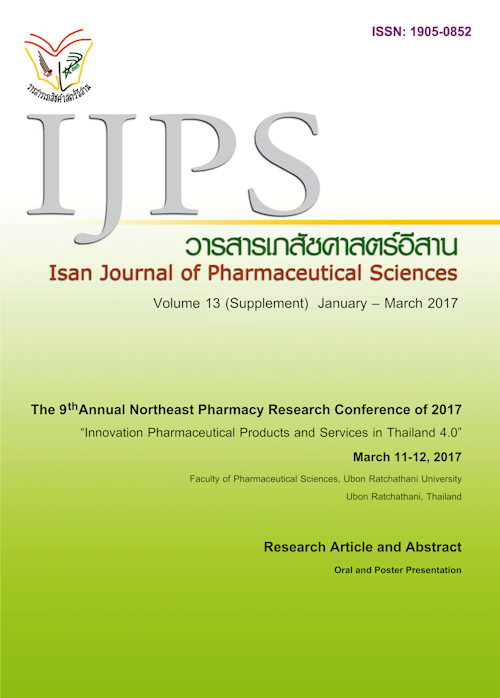Drug Use Evaluation of Non-Essential Drugs Focus on Angiotensin II Receptor Antagonists
Main Article Content
Abstract
Introduction: National list of essential drugs was published in 1981 by Thai Ministry of Public Health (MOPH) in order to control the health care cost. Non-essential drugs (Non-ED) are the drugs those are not in that list. Prescribing Non-ED should be restricted since they are expensive and sometimes essential drugs can be used instead. Drug use evaluation of Non-ED focus on Angiotensin II receptor antagonists (ARBs) at Damnoen Saduak Hospital (DNSH) was performed. The objective of this study is to evaluate how the prescribing of Non-ED ARBs complied with the developed criteria in the aspects of indications and contraindications. Methods: The criteria of appropriate NON-ED ARBs prescribing had been developed from academic references and also the MOPH guideline of Non-ED prescribing. Data were retrospective collected from medical records, patient database and also the DNSH{s drug use evaluation forms. Data were collected for 3 years (from October1, 2011 to September30, 2014) Results: The total prescriptions of Non-ED ARBs during the study period were 260. It was found that there were 7(2.69%) and 36 (13.84%) prescriptions that were appropriate usage in the aspects of indications and contraindications respectively. Concerning both aspects, there were 4 (1.53%) appropriate prescriptions. Conclusion: There were not many Non-ED ARBs prescriptions which were complied with the developed criteria. Moreover, there were many prescriptions which could not be evaluated. As the result, hospital guideline of prescribing of Non-ED ARBs should be developed to fit in with the hospital context and notified to the physicians to promote appropriate drug use in the future.
Article Details
In the case that some parts are used by others The author must Confirm that obtaining permission to use some of the original authors. And must attach evidence That the permission has been included
References
Agency for Healthcare Research and Quality (AHRQ). Comparative Effectiveness of Angiotensin-Converting Enzyme Inhibitors (ACEIs) and Angiotensin II Receptor Antagonists (ARBs) for Treating Essential Hypertension: AHRQ Executive Summary [internet]. 2007 [cited 2014 Aug 21]. Available from: URL:https://www.effectivehealthcare.ahra.gov/ehc/products/12/45/ACEI_ARBFulARBFull.pdf.
Chaisuksant L. A comparative survey of criteria used by regional and general hospital for drug use evaluation of anti infective agents in the restricted drug groups of the national list of essential drugs 1999. [Thesis/Master of Pharmacy]. Nakorn-Pathom: Silpakorn University; 2001.
Chulavatnatol S and Montakantikul P. DUE: A step wise approach for rational drug use. Bangkok: ChanMuang Printing; 2010
Diabetes Association of Thailand under The Patronage of Her Royal Highness Princess Maha Chakri Sirindhorn. Clinical practice guideline for Diabetes 2014 Bangkok: Arun Printing; 2014
Jackson EK. Renin and angiotensin. In: Hardman JG, Limbird LE, Gilman AG, editors. Goodman & Gilman {s the pharmacological basis of therapeutics. 10th ed. New York: The McGraw-Hill Companies, Inc; 2001. p. 809-42.
James PA, Oparil S, Carter BL, Cushman WC, Dennison-Himmelfarb C, Handler J, et al. 2014 Evidence-Based guideline for the management of high blood pressure in adults JAMA. 2014; 311(5): 507-520.
Kangsaworn P, Waleekhachonloet O, Limwattananon C and Sumon Sakolchai. Drug use review of bisphosphonates and raloxifene for osteoporosistreatment at the postmenopausal clinic, health promoting hospital, Regional Health Promotion Center 6. IJPS 2008; 4(2): 46-56.
KDIGO board members. Clinical practice guideline for the Evaluation and Management of Chronic Kidney Disease (KDIGO, 2012). Kidney International Supplement [internet]. 3(1): 2013 [cited 2017 Jan 12]. Available from: URL:http://www.kidney-international.org
National Drug Committee. National list of essential medicines. 2008. 1st ed. Bangkok: Thai Agricultural Cooperatives Printing;2008
Ministry of Public Health (MOPH). Criteria for drug utilization evaluation (control monitor and evaluate) in the hospitals. Formal Documentation from Ministry of Public Health to all hospital directors. MOPH 0228.07.1.3/ 298. June15, 2011.
James PA, Oparil S, Carter BL, et al. 2014 Evidence-based guideline for the management of high blood pressure in adults: report from the panel members appointed to the Eighth Joint National Committee (JNC 8). JAMA.2014; 311 (5): 507^20.
Rational drug use promoting subcommittee. Rational drug use hospital manual. 1st ed. Bangkok: Thai Agricultural Cooperatives Printing.; 2015
Soontornpas C, Limwattananon C, Thiamkao S and Soontornpas R. Physicians’ attitude toward non-essential drug prescription criteria measure. IJPS 2015; 11Suppl: 108-111
The Heart Association of Thailand under the Royal Patronage. Guideline for ischemic heart disease 2014. BangKok: SriMuang Printing; 2014
Weber MA. The angiotensin II receptor blockers: opportunities across the spectrum of cardiovascular disease. Rev Cardiovasc Med 2002; 3(4): 183-91.
Yancy CW, Jessup M, Bozkurt B, Butler J, Casey DE, Drazner MH. 2013ACCF/AHA Guideline for the Management of Heart Failure A Report of the American College of Cardiology Foundation/American Heart Association Task Force on Practice Guidelines. Circulation. 2013; 128: 1810-1852


